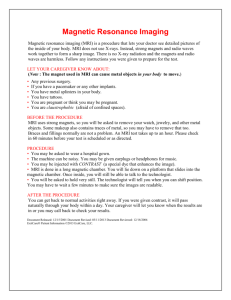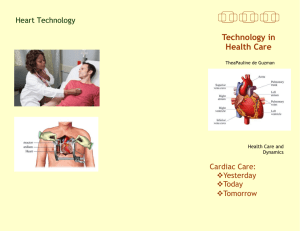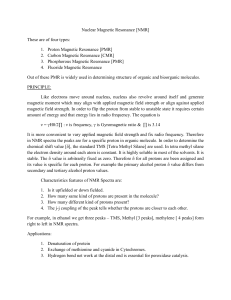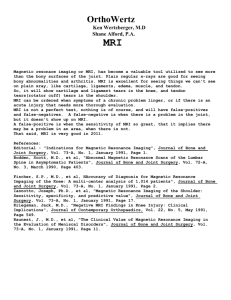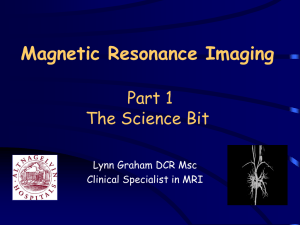MRI
advertisement
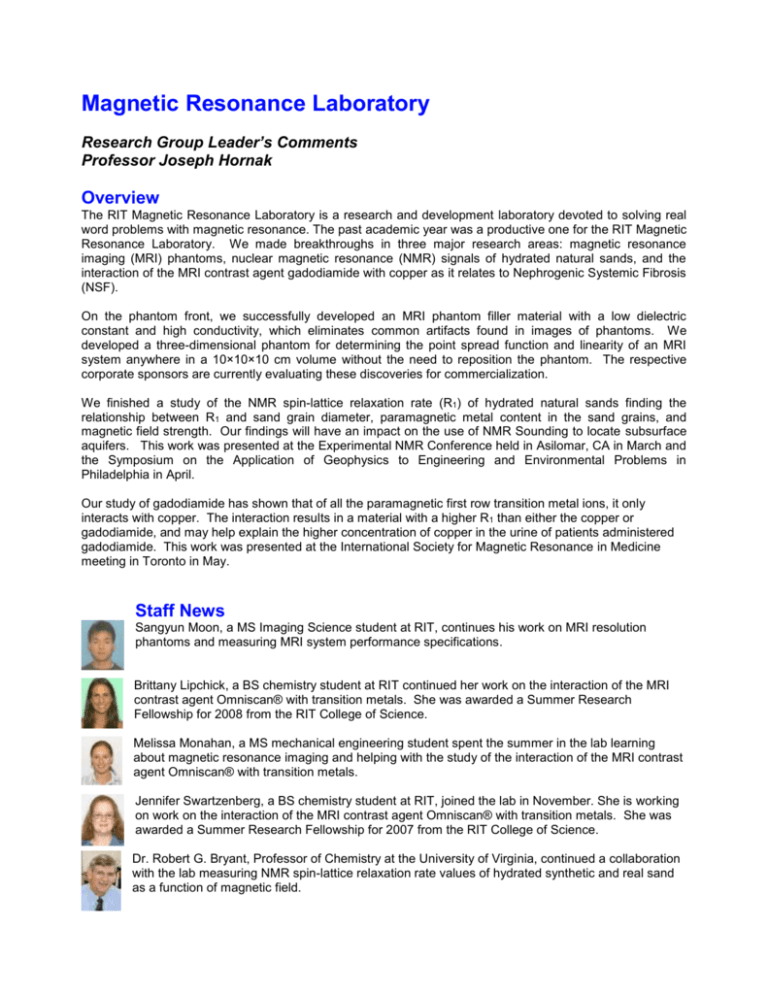
Magnetic Resonance Laboratory Research Group Leader’s Comments Professor Joseph Hornak Overview The RIT Magnetic Resonance Laboratory is a research and development laboratory devoted to solving real word problems with magnetic resonance. The past academic year was a productive one for the RIT Magnetic Resonance Laboratory. We made breakthroughs in three major research areas: magnetic resonance imaging (MRI) phantoms, nuclear magnetic resonance (NMR) signals of hydrated natural sands, and the interaction of the MRI contrast agent gadodiamide with copper as it relates to Nephrogenic Systemic Fibrosis (NSF). On the phantom front, we successfully developed an MRI phantom filler material with a low dielectric constant and high conductivity, which eliminates common artifacts found in images of phantoms. We developed a three-dimensional phantom for determining the point spread function and linearity of an MRI system anywhere in a 10×10×10 cm volume without the need to reposition the phantom. The respective corporate sponsors are currently evaluating these discoveries for commercialization. We finished a study of the NMR spin-lattice relaxation rate (R1) of hydrated natural sands finding the relationship between R1 and sand grain diameter, paramagnetic metal content in the sand grains, and magnetic field strength. Our findings will have an impact on the use of NMR Sounding to locate subsurface aquifers. This work was presented at the Experimental NMR Conference held in Asilomar, CA in March and the Symposium on the Application of Geophysics to Engineering and Environmental Problems in Philadelphia in April. Our study of gadodiamide has shown that of all the paramagnetic first row transition metal ions, it only interacts with copper. The interaction results in a material with a higher R1 than either the copper or gadodiamide, and may help explain the higher concentration of copper in the urine of patients administered gadodiamide. This work was presented at the International Society for Magnetic Resonance in Medicine meeting in Toronto in May. Staff News Sangyun Moon, a MS Imaging Science student at RIT, continues his work on MRI resolution phantoms and measuring MRI system performance specifications. Brittany Lipchick, a BS chemistry student at RIT continued her work on the interaction of the MRI contrast agent Omniscan® with transition metals. She was awarded a Summer Research Fellowship for 2008 from the RIT College of Science. Melissa Monahan, a MS mechanical engineering student spent the summer in the lab learning about magnetic resonance imaging and helping with the study of the interaction of the MRI contrast agent Omniscan® with transition metals. Jennifer Swartzenberg, a BS chemistry student at RIT, joined the lab in November. She is working on work on the interaction of the MRI contrast agent Omniscan® with transition metals. She was awarded a Summer Research Fellowship for 2007 from the RIT College of Science. Dr. Robert G. Bryant, Professor of Chemistry at the University of Virginia, continued a collaboration with the lab measuring NMR spin-lattice relaxation rate values of hydrated synthetic and real sand as a function of magnetic field. Yana Goddard, Post Doctoral Associate in the laboratory of Prof. Bryant at the University of Virginia, collaborated with the lab measuring NMR spin-lattice relaxation rate values of hydrated synthetic and real sand as a function of magnetic field. Gianni Ferrante, President of Stelar, s.r.l, Mede, Italy, continued his collaboration with the lab measuring NMR spin-lattice relaxation rate values of hydrated real-sand as a function of magnetic field. Dr. Sandip Sur, Director of the NMR facility in the Chemistry Department at the University of Rochester continued a collaboration working on the electron paramagnetic resonance (EPR) of quartz sands. Grants and Contracts An exploration into the development of MRI phantom filler materials—INVIVO Corp., 2007-2008, $60k. An NMR Study of the Interaction of Metal Ions with Gd(DTPA-BMA) - RIT COS, 2008, $3k. The Structure of the Components of a Mixture of Cu Plus Gd(DTPA-BMA) - RIT COS, 2008, $3k. Quantitative MRI: A 3D Resolution Phantom, RIT CIS-Kodak Research Grants, 2007, $5k. Publications Fundamentals of MRI, Part IX: Advanced Imaging Techniques, CE Source, Enterprises for Continuing Education, 7(2): 1-9, Fall 2007. (1 CEU) B.J. Antalek, W. Windig, J.P. Hornak; “Multivariate Image Analysis of Magnetic Resonance Images: component resolution with the Direct Exponential Curve Resolution Algorithm (DECRA).” Techniques and Applications of Hyperspectral Image Analysis, ed. by H.F. Grahn and P. Geladi, Wiley, 2007. C.L. Bray, J.P. Hornak, Unilateral MRI using a Rastered Projection. J. Magn. Reson. 188:151-159 (2007). J.P. Hornak, Labels Printed with Magnetic Toner, Magn. Reson. Imaging, 25:1459-1460 (2007). C.L. Bray, R.G. Bryant, M.J. Cox, G. Ferrante, Y. Goddard, S. Sur, J. P. Hornak, The 1H NMR Spin Lattice Relaxation Rate of Hydrated Sands. Submitted J. Env. & Eng. Geophys 2007. Conference Presentations B.C. Lipchick, M. Monahan, J.P. Hornak, An Interaction of Gadodiamide with Cu+2, Rochester ACS Harrison Howe Poster Session, Rochester, NY, March 2008. J.P. Hornak, C.L. Bray, R.G. Bryant, M.J. Cox, G. Ferrante, Y. Goddard, S. Sur, The NMR Spin Lattice Relaxation Rate of Hydrated Sands as a Function of Magnetic Field, SAGEEP, Philadelphia, PA, April, 2008. B.C. Lipchick, M. Monahan, J.P. Hornak, An Interaction of Gadodiamide with Cu+2, Rochester ACS Undergraduate Research Symposium, Geneseo, NY, April, 2008. J.P. Hornak, B.C. Lipchick, M. Monahan, An Interaction of Gadodiamide with Cu+2 and Zn+2, 16th ISMRM, Toronto, CA, May, 2008. C.L. Bray, R.G. Bryant, M.J. Cox, G. Ferrante, Y. Goddard, S. Sur, and J.P. Hornak, The 1H NMR R1 of Some Hydrated Synthetic and Natural Sands, 9th International Conference on Magnetic Resonance in Porous Media, Cambridge, MA July 2008. J.P. Hornak, MRI: Where we are at and where we are going, Plenary Lecture, American College of Veterinary Radiology Annual Scientific Meeting, Chicago, IL, November 2007. New Equipment and Facilities The lab acquired a, AEA Technologies vector impedance analyzer for tuning radio frequency coils. We constructed an RF dielectric probe for measuring the dielectric constant and resistivity of solutions from 100 kHz to 200 MHz. This probe was essential to the study of filler materials for MRI phantoms.

